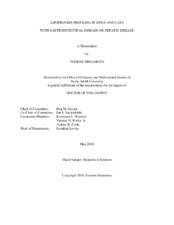| dc.description.abstract | Canine and feline hyperlipidemia is associated with various diseases and can cause clinically relevant complications, such as cutaneous xanthomas, hepatobiliary diseases (e.g., cholelithiasis, cholestasis, vacuolar hepatopathy, snf bilisty mucocele), pancreatitis, glomerular disease, lipemia retinalis, or peripheral neuropathy. However, dyslipidemia has not been extensively investigated in dogs and cats, maybe in part because dogs and cats are high-density lipoprotein (HDL) predominant species and the development of atherosclerosis is rare. This study aimed to evaluate the lipoprotein profile by continuous lipoprotein density profiling (CLPDP) method in dogs and cats with various gastrointestinal (GI) diseases, including exocrine pancreatic insufficiency (EPI), chronic enteropathy (e.g., idiopathic inflammatory bowel disease), and hepatic diseases. The CLPDP is a novel density gradient ultracentrifugation (DGU) technique, which uses a self-generating density gradient solution, bismuth sodium ethylenediaminetetraacetic acid (NaBiEDTA), and a fluorescent probe, N-[7-(4-nitrobenzo-2-oxa-1,3-diazole)]-6-aminocaproyl-D-erythro-sphingosine (NBD C6-ceramide). We performed the partial validation assay of the CLPDP assay for use with canine serum samples. The intra- and inter- assay variability showed that the CLPDP was precise and reproducible for nominal low-density lipoprotein (LDL)/HDL and HDL, whereas the method was precise but not reproducible for TRL.
Our study showed that patients with GI diseases that lead to malassimilation (i.e., exocrine pancreatic insufficiency [EPI] and chronic enteropathies) most likely have decreased serum lipid concentrations consisting of LDL and high-density lipoproteins HDL compared to healthy control animals. Cats with hepatic lipidosis had divergent lipoprotein profiles compared to healthy control cats. The amounts of lipid within the density of 1.0374-1.0438 g/mL
distinguished healthy control cats from cats with HL with a sensitivity of 87% and a specificity of 90%. Dogs with liver disease (i.e., chronic hepatitis: CH or portosystemic shunt:PSS) had significantly different lipoprotein profiles compared to healthy control dogs. Dogs with PSS had significantly decreased levels of lipoprotein fractions compared to dogs with CH and healthy control dogs. These findings could potentially have diagnostic and prognostic implications in dogs and cats with GI disease. In addition, lipoprotein profiles may aid in the better understanding of the role of lipid metabolism in GI diseases and may even aid in the development of novel therapeutic approaches. | en |


